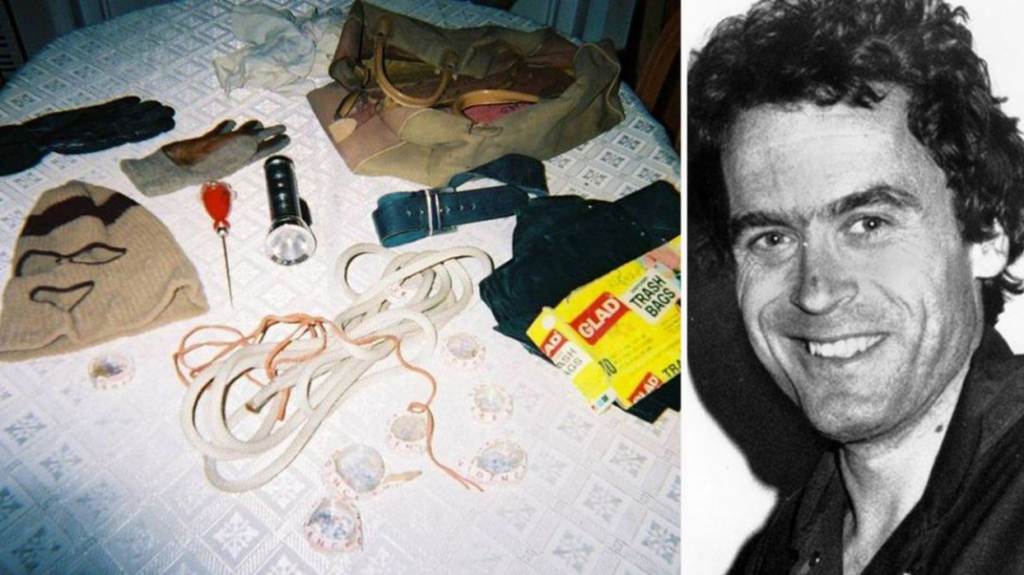Throughout his life, the infamous American serial killer Theodore Robert Bundy did not show value for human life or care about the consequences of his horrific actions; he was unable to feel pity, remorse, or empathy. The killer was callous and extremely brutal with his victims. Ted Bundy murdered, raped, and kidnapped over 30 young women and girls during the 1970s and possibly even earlier. After denying all accusations for over a decade, Bundy then confessed to 30 murders he committed in seven states between 1974 and 1978. Although only 20 such murders were confirmed, the Florida Supreme Court suspects that the actual number is well over 36. Additionally, Bundy was incarcerated multiple times and successfully escaped numerous times, and committed new crimes each time.
“I don’t feel guilty for anything. I feel sorry for people who feel guilt.”
Ted Bundy
Theodore Bundy’s Early Years: Life Before Crime
Bundy had an uneventful childhood and was a socially awkward child who often crossed lines of proprietary, morality, and legality. However, this behavior in his younger years proved no excuse for his future actions; most rebellious children do not later become serial rapists and murderers. Bundy was born at a home for unwed mothers and his mother, Louise, initially wanted to put him up for adoption but her father wanted the child to grow up in Philadelphia with his family. The family ultimately decided on telling Bundy that his mother, Louise, was his sister, a lie that the young boy did not believe. In the long run, this lie caused Bundy much built-up anger. Bundy’s grandmother was diagnosed with depression and agoraphobia while his grandfather had a raging temper which he projected by torturing the family’s pet dog, swinging cats by their tails, and beating his wife. Experts theorize that Bundy was abused at the hands of his grandfather although Bundy insists that they had a good relationship. The boy wasn’t the “weirdest” kid at school but lacked some social graces. He performed decently in school but never excelled academically.
Theodore Bundy’s Teenage Years
As Bundy grew up he developed violent tendencies and began to break the law. The teenager liked to scare people and see the fear in others’ eyes. For instance, Bundy constructed “tiger traps” which were deep holes in the ground in which he’d place spikes; he’d cover the opening in vegetation, and wait for someone to fall in. Bundy additionally enjoyed gruesome stories which depicted rape and gore-filled scenes. He particularly enjoyed watching violent porn since adolescence, and would even consume the explicit content while at school. Not long after, Bundy began breaking the law. He would shoplift items he desired but couldn’t afford and even attempted car theft. One of the most disturbing things he did as a teen was spying on strangers. This act, known as voyeurism, is a common precursor to sexual violence. Bundy showed numerous concerning behaviors that should have been contained before reaching the level that they did, and for that, his family is partially to blame.
What drove Bundy to kill? Who did he target?
“Driven by obsessive homicidal fantasies, Bundy was compelled to murder repeatedly to satisfy his terrible desires.” says The Sun. Ted also had a lot of built-up anger from his childhood but psychologists say that the victims that Ted targeted were connected to the end of his first relationship. Bundy met Diane Edwards at the University of Washington and says that she was upper class, had a nice car, and a great family. Bundy admits that their relationship brought out many of his own insecurities; for example, he couldn’t afford to take her out as she expected and generally felt that she was out of his league. When Diane ended things, Bundy claims that he had the desire to get “some sort of revenge” on her. Psychologists that worked on Bundy’s case speculate that the ending of their relationship spurred his killings. Almost all of Bundy’s victims strongly resemble Diane (white, slim, with long dark hair) suggesting that he was taking out his anger of their breakup on other women who looked like her. This gave Ted the feeling of hurting her even though he never actually touched her.
As stated previously, Bundy became addicted to graphic and violent pornography. He admitted that it was a genuine addiction and that after a while the only thing that would bring him satisfaction was acting out his fantasies which were influenced by what he watched.
Bundy’s Ruse
Bundy would typically approach women in public areas as an injured man trying to load something into his car or by feigning a disability and asking for help. Then the cold-blooded killer would kidnap his victim and assault them in a secluded location. After putting his victim’s corpse in a place he thought no one would find them, he would occasionally revisit their cadaver to groom and have sex with it. He continued this behavior until the body was so decomposed that no further contact was possible. Bundy’s affinity for necrophilia stemmed from the act’s total elimination of the possibility of unwanted rejection, an affirmation that made him feel superior, and empowered. Bundy took Polaroid pictures of his dead victims as trophies of his “accomplishments.” To add to this collection of trophies, Bundy sometimes took his victims’ decapitated heads home, where he’d shampoo their hair and apply makeup to their faces. Bundy was a manipulative and persuasive man, and he managed to convince his mother and wife, Carol Boone, that he was innocent.

Victors and Survivors
Carol DaRonch was eighteen years old when she was approached by Ted Bundy. In the summer of 1974, Bundy approached DaRonch under the guise of a police officer in a mall and claimed that her car had been broken into. Carol noticed that something was odd about him so she asked to see his badge, which Bundy presented. Thus, believing in Bundy’s story, Carol agreed to go down to the police station with the man. Instead, however, he drove into a small backstreet behind an elementary school and tried to handcuff her. DaRonch managed to escape through the car door, and before Bundy could knock her out with a crowbar, she spotted a car and ran toward it. “I saw his blank, beady, and lifeless eyes,” said DaRonch after the attack. Enraged that his target had escaped, Bundy became so enraged that he went out and killed another woman a mere four hours later. Other survivors include Sotria Kritsonis, Rhonda Stapley, Kathy Kleiner, and Karen Chandler, who were all brutally attacked by Bundy in a sorority house. In contrast to all of his other victims, these fortunate few live to tell their stories that left them all scarred for life.


Bibliography:
Bonn, Scott. “Examining Serial Killer Ted Bundy.” Psychology Today, 30 December 2019, https://www.psychologytoday.com/intl/blog/wicked-deeds/201912/examining-serial-killer-ted-bundy. Accessed 9 May 2023.
Canning, Kristin. “Ted Bundy’s Motives, Explained – Why Did Ted Bundy Murder Women?” Women’s Health, 8 May 2019, https://www.womenshealthmag.com/life/a27407386/ted-bundy-motives/. Accessed 13 May 2023.
Dobson, James. “Ted Bundy.” Wikipedia, https://en.wikipedia.org/wiki/Ted_Bundy. Accessed 9 May 2023.
Jenkins, Philip. “Ted Bundy | Biography, Crimes, Death, & Facts.” Encyclopedia Britannica, 28 March 2023, https://www.britannica.com/biography/Ted-Bundy. Accessed 9 May 2023.
Kettler, Sara. “Inside Ted Bundy’s Troubled and Disturbing Childhood.” bio. Biography.com, 14 July 2020, https://www.biography.com/crime/ted-bundy-childhood. Accessed 9 May 2023.
Medeiros, Madison, et al. “Ted Bundy Survivor Carol DaRonch Harrowing Escape Story.” Refinery29, 24 January 2019, https://www.refinery29.com/en-us/2019/01/222434/carol-daronch-ted-bundy-survivor-escape-netflix-documentary. Accessed 17 May 2023.
Mullin, Gemma, and Piers Morgan. “How many people did Ted Bundy kill?” The Sun, https://www.thesun.co.uk/news/5791674/ted-bundy-serial-killer-victims/. Accessed 9 May 2023.
Plackett, Benjamin. “The Neurological Differences Between Psychopaths and Sociopaths.” Discover Magazine, 8 August 2021, https://www.discovermagazine.com/mind/the-neurological-differences-between-psychopaths-and-sociopaths. Accessed 9 May 2023.
Saunokonoko, Mark. “Ted Bundy: Charm looks hid evil serial killer in plain sight.” 9News, 24 January 2019, https://www.9news.com.au/world/ted-bundy-charm-looks-hid-evil-serial-killer-crime-news/c924b921-c461-4596-846d-60a647f0147b. Accessed 13 May 2023.“
Theodore Robert BUNDY v. FLORIDA | Supreme Court | US Law | LII / Legal Information Institute.” Law.Cornell.Edu, https://www.law.cornell.edu/supremecourt/text/479/894. Accessed 9 May 2023.

